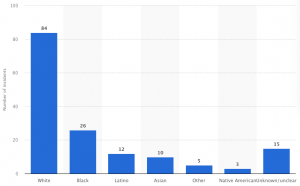None of the above! These are actual posters from the US Department of Labor.
To be honest, the Soviet propaganda had a lot more style and sincerity. The modern American stuff just looks like AI slop.
None of the above! These are actual posters from the US Department of Labor.
To be honest, the Soviet propaganda had a lot more style and sincerity. The modern American stuff just looks like AI slop.
Put this post by Donald Trump on Truth Social front and center when he’s tried for treason.

“I love the smell of deportations in the morning…”
Chicago about to find out why it’s called the Department of WAR
He thinks it is amusing to threaten an American city of almost 3 million people with apocalyptic destruction. He’s a criminal despot.
His pretext is that crime is too high in Chicago. Unfortunately for that excuse, invading the city to deport a subset of people whose primary “crime” is being brown and speaking Spanish would not address that problem, the statistics show that crime has been declining already, and Chicago is not the most crime-ridden city in the country. That distinction belongs to cities in red states.
The four cities of populations larger than 100,000 with the highest murder rates in 2024 are in Republican states: Jackson, Mississippi (78.7 per 100,000 residents), Birmingham, Alabama (58.8), St Louis, Missouri (54.1) and Memphis, Tennessee (40.6).
…Chicago is bracing to be the next city targeted by the Trump administration. To date this year, 278 people have been killed in Chicago, 118 fewer people killed when compared with 2024. It is at pace for 412 deaths for the year, which would be a rate of about 15 per 100,000 residents. The rate is likely to be lower still than that, because homicide rates increase during summer months.
The Windy City ranked 37th in homicide rate in 2024 for cities larger than 50,000 residents in the United States. For cities with more than 100,000 residents, it placed 14th. This year, it is likely to slide farther down the list, even as violence falls to 60-year lows.
What are the National Guard going to do in Chicago, anyway? Stand around on street corners, eat deep dish pizza, guard the Bean in Millennium Park, visit the Field Museum? Trump is putting on a show, the same as renaming the Department of Defense the Department of War was an empty gesture.
Wait, no, that’s not true — the Republicans are gunning for everyone who is tolerant of other people’s sexual orientation. The gays are just next in line.
This is reminding me of the 80s, when Ronald Reagan was leading an affable campaign of hatred. Rand Paul is a hardcore anti-gay crusader, always has been, but in the current political climate he’s more free to expose himself.
One of the people who resigned in opposition to the destruction of the CDC was Demetre Daskalakis, who Paul has decided was unfit for his position anyway.
Asked about the resignations on Tuesday (2 September), Sen. Paul said: “One of the guys that is the biggest proponent of doing all this is the guy who describes the risky behaviour that he and his lifestyle involve.
“A guy that is so far … out of the mainstream, I think most people in America would discount his opinion because of the things he said in the past. He does not represent the mainstream of anything in America,” he went on.
“He should have never had a position in government. He brags about his lifestyle, you know, this whole idea of bondage and, you know, multiple partners and all that stuff. He brags about that stuff, but he’s got no business being in government. It’s good riddance.”
Being out of the mainstream in one’s personal preferences and behavior has never (or should never) be a criterion in determining one’s expertise in doing science. I thought Paul was a Libertarian? To be honest, being a Libertarian should disqualify you from ever holding office, but fortunately I don’t have the power to make that decree.
Even worse, there is a candidate running to replace Dan Crenshaw, which normally I’d approve of — he’s poison. But the person running against him is Valentina Gomez, a woman who is upset that there are lesbians in the WNBA, who wants to take a flamethrower to books that “groom” children.
When I’m Secretary of State, I will 🔥BURN🔥all books that are grooming, indoctrinating, and sexualizing our children. MAGA. America First🇺🇸 pic.twitter.com/m8waKi3yhP
— Valentina Gomez (@ValentinaForUSA) February 6, 2024
The video ends with an image of Gomez smiling into the camera, holding an AR-15 with an ammunition holder tied around her waist in front of a Tesla Cybertruck.
Charming. Fortunately, she has little hope of getting elected — she previously ran for the Secretary of State of Missouri, and came in 6th place with 8% of the vote. That’s more than she deserved, but it tells you about the power of being rabidly anti-gay.
Tomorrow at 2pm Pacific Time, the crew here at Freethoughtblogs are going to talk about some of the books we’ve read, with a focus on what we can learn for our own societies from them.
(Note: I’ve been really terribly sick today, but I think it’s one of those 24 hour things, so I hope I’ll be in shape to participate. Should be.)
RESCHEDULED: We’ll host this podcast on Saturday, 13 September instead.
They’re coming to take away the guns!
“In the wake of the Minneapolis Catholic church shooting, senior Justice Department officials are weighing proposals to limit transgender people’s right to possess firearms,” CNN reports.
“Such a move would represent a dramatic escalation of the Trump administration’s fight against the rights of transgender Americans.”
Interesting. The majority of trans people are not mass murderers, so this is a plan to punish the innocent for one person’s actions. As long as we’re going down this road, I must point out that 98% of the perpetrators of these shootings are men, and further, that the majority are white men.

Obviously, the most effective approach would to limit white men’s right to possess firearms. It’s the only statistically sensible plan.
It’s another anatomical atrocity from the bowels of the internet. Be amazed at the magnitude of the physical differences between men and women (although I hope this was exaggerated by some online comedian.)
I had no idea that women’s larger hips were all filled with an enlarged bony structure, contrary to my limited experience, or that women’s feet evolved specifically for wearing high heels.
I’d heard a few rumors about this program, Chorus, in which pro-Democrat ‘influencers’ formed a bloc to coordinate their support for liberal policies, which superficially sounded like a good idea, except for how it is implemented. Members had to swear secrecy, promise to never criticize their fellow Chorus members, and get their opinions vetted by their paymasters. This sounds an awful lot like the secret deal Tim Pool, Dave Rubin, and Benny Johnson made with Russians, except that the pay was much lower, $8000/month rather than hundreds of thousands of dollars. I consider transparency to be a significant value, so Chorus goes directly against that.
Rebecca Watson summarizes the story for us.
I’m convinced now that I shouldn’t trust Brian Tyler Cohen and David Pakman, because they are unable to be forthright about their perspective or who is paying them. I like my sources to be open and unconstrained by big money.
So much of the nonsense about the gender binary is projection, and imposition of cultural biases on top of biology. Case in point: this very silly post that claims that putting feathers on dinosaurs is a woke attempt to make them more feminine.
Male and female birds and dinosaurs had feathers, it wasn’t like a drag queen draping themselves in a feather boa. Also, the change in size is, I think, an echo of the Jurassic Park velociraptors, which were portrayed as much larger than the fossils showed — it was a case of Spielberg making them bigger to be more threatening, most definitely not scientists shrinking them down to make them more feminine.
Whoever was trying to make this case has not raised chickens, which given the right temperament can be utterly terrifying in their ferocity, despite being small and feathered.
We don’t have the Epstein files, but back in 2015 the contents of his little black book were published, and now New York Magazine has gone through his list of contacts and summarized them. Most of them are incidental encounters — Epstein was a pick-me boy who was straining to get the attention of establishment figures, and some of them were happy to get chummy with a rich guy. Unanswered, though, is how he got all his money; what’s clear and unsurprising is that a great many East Coast wealthy socialites were more than willing to overlook his conviction for child trafficking to go to his parties.
There’s a long section on Bill Clinton, for instance. I wouldn’t mind seeing more of the facts about the Bill Clinton/Jeffrey Epstein relationship exposed, and wouldn’t be at all surprised to learn that he took advantage of Epstein’s underage “clients,” and that there’s a whole rotten mob of unscrupulous exploiters thriving in the upper crust. Take ’em all out.
One name on the list jumped out at me: John Brockman, agent for scientific “freethinkers.” Brockman was my agent! I contributed to some of his books! I guess I have a very thin, tenuous connection to one person on the Epstein list. (Don’t worry, I never was invited to any of Brockman’s Edge symposia, let alone got a ride on the Lolita Express. I was very bottom-of-the-barrel in the Brockman universe.) Nothing in NYMag about him was a surprise, but I’m relieved to say that the thread connecting me to that group was very thin.
What seems new, in flipping through the reams of society photos of perhaps the world’s most prolific sexual predator that have been circulating over the past few weeks, is not the powerful and the beautiful who surrounded Epstein, but the intellectuals — the Richard Dawkinses, the Daniel Dennetts, the Steven Pinkers. All men, of course. But the group selfies probably shouldn’t have been a surprise — documents of an age in which every millionaire doesn’t just fancy himself a philosopher-king but expects to be treated as such, and every public intellectual wants to be seen as a kind of celebrity.
Cultural shifts like these require visionaries, networkers, salespeople. Brockman is one. A Warhol Factory kid turned freelance philosopher of science turned literary agent to Dawkins and Dennett and Pinker (and many others), in the 1980s he formed a casual salon of like-minded scientists and futurists that came to be known as the Reality Club, a knock against the poststructuralism then dominant in the academy. In the 1990s, he rebranded it as the Edge Foundation, an organization whose central event was an annual online symposium devoted to a single, broad question. In 2000, it was “What is today’s most important underreported story?” In 2006, “What is your dangerous idea?”
Epstein was a regular contributor, and his plane — to judge from the photographs, at least — was an especially appealing way for other contributors to get to ted. They could also catch Epstein at Harvard, where so many of them taught and where he became so prolific a donor that one whole academic program seemed to be run like his private Renaissance ateliers. Epstein had long described himself as a “scientific philanthropist,” and in a press release put out by the Jeffrey Epstein VI Foundation announcing its “substantial backing” of Edge, he called it “the world’s smartest think tank.”
Many in Brockman’s Edge community are, or were, inarguably significant figures in the American intellectual Establishment: Freeman Dyson, Jared Diamond, Craig Venter, John Horgan, Paul Bloom (to name a random but representative sample). They are also among the gods and heroes of the Trump-era internet community of “freethinkers,” whom Eric Weinstein, the venture capitalist and regular Edge contributor, memorably called “the intellectual dark web.” The name suggests a self-glamorizing style of dangerous discourse, and as soon as the community was identified, it was criticized as revanchist, an effort to reopen areas of intellectual inquiry — about innate differences between the races, say, or the genders — now considered problematic, at a minimum. But to listen to the IDW warriors themselves — talking about the “war on free speech” as though their universities had sent assassins their way rather than tenured chairs — their crusade seems motivated just as much by a thin-skinned sense of their own world-historical significance. They were special people, deserving of special acclaim and, of course, special privileges.
Many contributions to Edge were plausibly the products of genuinely special minds. Epstein’s were not. In 2008, the year he went to jail for prostitution, the prompt was “What have you changed your mind about?” Epstein replied, “The question presupposes a well defined ‘you’ and an implied ability that is under ‘your’ control to change your ‘mind.’ The ‘you’ I now believe is distributed amongst others (family friends, in hierarchal structures), i.e. suicide bombers, believe their sacrifice is for the other parts of their ‘you.’ The question carries with it an intention that I believe is out of one’s control. My mind changed as a result of its interaction with its environment. Why? Because it is a part of it.”
“Jeffrey has the mind of a physicist,” the Harvard professor Martin Nowak has said, incredibly. But what he really did have was the life of a very rich person — unable to see any world he felt unqualified to enter and surrounded by too many people enamored with his money to ever hear the word no.
At least I can say that I spotted the bullshit of the IDW on day one.
 When capitalism trumps science…this is Donald Morisky. He developed a useful tool called the Morisky Medication Adherence Scale, a questionnaire you can use to determine the likelihood someone will stick to a regimen of medication. It’s only 8 questions long, but I can see how it would be valuable.
When capitalism trumps science…this is Donald Morisky. He developed a useful tool called the Morisky Medication Adherence Scale, a questionnaire you can use to determine the likelihood someone will stick to a regimen of medication. It’s only 8 questions long, but I can see how it would be valuable.
Don’t belittle it because it’s only 8 questions, though. The hard part is validation — you’ve got to run it through a lot of trials and actually confirm its accuracy. So I expect that Morisky actually invested a lot of effort in the project.
There is some controversy over it, but that’s to be expected — it’s psychology, after all.
The tool initially involved four questions but in 2008 expanded to eight. But the paper describing the longer questionnaire was retracted in 2023 after one critic claimed the scale was no more accurate than flipping a coin.
The usual reward for this kind of research is that you publish it, you get respect and fame for it, and then researchers around the world cite your paper and you get even more well known. You get tenure. You get invited to talk at conferences about your scale. The usual.
Morisky took a different route. He published it, and then slapped a copyright on it, and allowed other researchers to use it IF they coughed up a hefty fee. The fee seems to be wildly plastic — some people get billed $500, others get a demand for $7500. Some get to use it for free.
Morisky has added a new wrinkle to his profit-making scheme: if he doesn’t get his money, he will demand that papers that used his scale be retracted.
By our count, there have been at least nine retractions for licensing issues related to the MMAS. But not all retractions of papers that use the scale explicitly cite a reason in the notice, so the number is likely higher.
Those might have been good papers, but that doesn’t factor at all into Morisky’s criterion: did they pay Morisky, or didn’t they? I call it corruption. The only responsible approach is to refuse to use the scale and to develop your own independent measures, but as I said above, that is hard work. In science, we’re supposed to be able to stand on the shoulders of those who came before us, but I guess you can’t if your predecessor was Donald Morisky.
